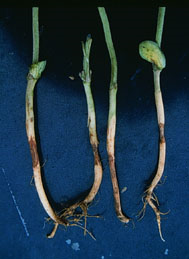Seedling Blights in Soybeans
Seedling Blights
Symptoms
Seed and seedling diseases can cause seeds to rot prior to germination or seedlings to rot and die before they

Seedling Blight in soybeans
University of Kentucky
emerge from the soil. Emerged seedlings will have varying degrees of root rot, lower stem cankering and rot, seed leaf lesions, and stunting. Plants may die or survive infection, depending on the severity of disease and growing conditions.
Generally only scattered individual plants or small groups of plants will be killed with seedling blights.
Several fungi can cause seedling blight and the symptoms observed may vary according to the fungi involved. Infected seedlings may contain small, black, dry sunken lesions on the cotyledons. Infected stem tissues may be translucent to brown or reddish in color. A soft, water rot is often produced. Dry weather causes infected plants to become dry and shredded. Outermost tissues of large roots may slough off. Smaller roots may be decayed and break away from plants when pulled from the soil.
Cause
Seedling blight and seedling disease are caused by various fungi. Depending on the fungus involved, they can survive in the seed, soil and infested crop residue.
Disease is usually promoted by adverse growing conditions and stress during seed germination and emergence. Low soil temperatures from 50 to 60 degrees F and high soil moisture are favorable to disease development. Low, wet areas of fields are likely to show the first symptoms of the disease.
Minimum tillage fields may be more prone to disease as are seed of lower germination and poor seed quality. Herbicide injury or insect damage to young seedlings may also increase seedling diseases, especially those caused by Rhizoctonia and Pythium.
IPM Techniques
- Fields should be check every two weeks from planting until vegetative stage.
- At each scouting site, examine two rows of plants ten feet in length .
- Look for dead or dying seedlings.
- The number of sites you will need to check in each field is based on the field size. To determine the number of scouting sites see the field size and number of locations chart.
- At each site you will need to note a rating of 0 to 3 based on the following scale:
0 =no disease seedlings;
1 = up to one infected plant per two foot of row, a few plants missing;
2 = between one and four infested plants per two foot of row, several plants missing;
3 = more than four diseased plants per two foot of row, many plants missing, obvious loss of yield expected due to poor stand.
- Plant high-quality, disease-free seed or certified seed. Rotate soybeans with other crops.
- Avoid planting in cool, wet soils.
- Maintain balanced soil fertility.
- Improve surface drainage patterns, where problems exist.
- Rotation of beans with other crops may reduce levels of some fungi. However, rotation will have little effect on fungi such as Rhizoctonia, Pythium, Phytophthora and Fusarium .
- Seed and seedling diseases are generally encouraged by reduced tillage systems.
References and Additional Information
- IPM-3 Kentucky IPM Manual for Soybeans
- PPA-10b Kentucky Plant Disease Management Guide for Soybean by D.E. Hershman, Extension Plant Pathology, University of Kentucky
- Compendium of Soybean Diseases, J.B. Sinclair and P. A. Backman (The American Phytopathological Society Press)


